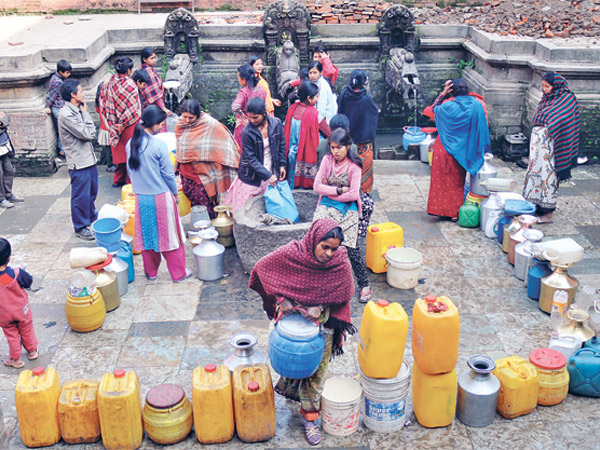
KATHMANDU, JUN 06 - The rains will be here in a little more than a week. For Patan’s and Bhaktapur’s denizens, that will provide some reprieve from the dry spell: the groundwater that feeds the ancient stone spouts will at long last get recharged. To prepare the wells for the new season, people in the older cities around the Valley, this week, scrubbed the water spouts, wells and the underground canal system—known as the Raj Kulo (the ‘royal irrigation system’)—as part of the Sithi Nakha festival. The canals connect the spouts to their sources in places as far afield as Tika Bhairab, in the Valley’s south.
Ages ago, during the Malla times, the Raj Kulo network, an integrated system, was constructed by Jitamitra Malla, to supply water to Patan and Bhaktapur. His descendants fortified the system and in modern times, the Newar communities living in the cities in the Valley became the caretakers of the system, because they depend on it to meet their water-needs to a large extent. The Raj Kulo is scientifically designed—the gravity-flow mechanism is divided into the following components: the watershed (the main water source); an underground piping system, with side channels for recharging the Valley’s ponds; filtration and sedimentation units made from rocks, stones and pebbles, built underground to provide clean water; and finally, the stone water spouts.
These water spouts, wells and ponds were the major sources of water for the locals, and they provided adequate water until the 1950s, when the government stopped the funds allocated for the maintenance of the Kulo, and many of the canals started drying out. Likewise, the urban sprawl, and the unmanaged construction of houses and commercial buildings, have put a strain on the Raj Kulo. Similarly, the introduction of piped-water systems, such as the Bir Dhara and Chandra Dhara by the Rana rulers, and later the establishment of the Nepal Water Supply Corporation to supply piped water, led to the abandoning of most of the traditional systems. The drying out of the water sources, poor management of the government-owned drinking-water supply system, and the lack of a big water-supply project, has forced people in places like Patan to start depending again on the old system. To retain their traditional water-supply points, the locals have already started rehabilitating and maintaining their original sources such as spouts, wells and ponds. As a supplement to the Kulo, the locals are today turning to newer ideas such as rainwater-harvesting.
According to Prakash Amatya, who leads the citizen campaign on water and sanitation in the Valley, it’s the failure of the government that has pushed the locals to try out alternatives and renovate the traditional sources that once used to feed them. In Lalitpur, for example, locals have revived stone spouts like Alko Hiti, Iku Hiti and Hiku Hiti. At present, the demand for drinking water in the Valley stands at 350 MLD (million litres per day), while the supply even during the rainy season is hardly around 150 MLD. The situation becomes acute in the dry season, with a sharp fall in supply, to around 90 MLD.
A study by the NGO Forum for Water and Sanitation recently found that of the total 389 stone spouts in the Valley, only 233 are naturally working. Similarly, 45 no longer exist, 68 have gone dry and 43 have been revived by connecting them to city supply lines. “If only the existing traditional water supply system were rehabilitated and properly managed, it could help take care of the water needs of a considerable population inside the Valley,” says Amatya.
Photos: Laxmi prasad ngakhusi
Text: pragati shahi

